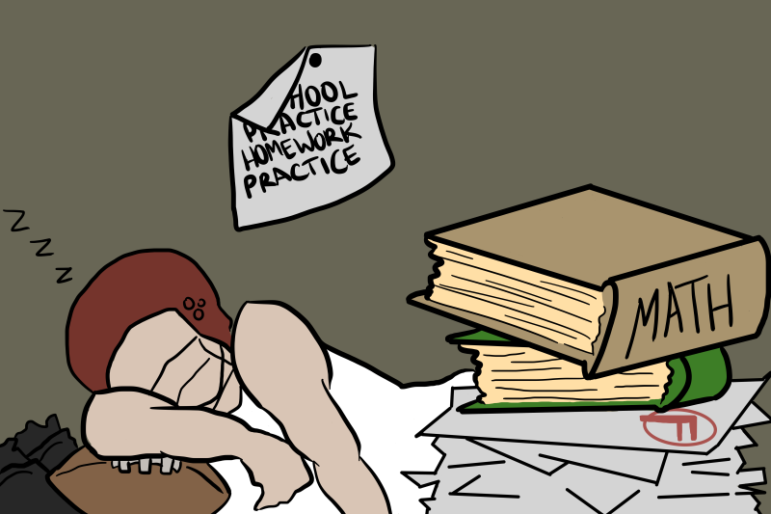

An average day in the life of a student athlete can start as early as 5:30 a.m. and end more than 17 hours later. For athletes who have morning practice, they must arrive at school hours before classes start. Some training sessions last for up to three hours a day. Many student athletes don’t get home until 6:30 p.m., and hours of homework to complete means most won’t go to sleep until late into the night.
Despite the packed schedules and taxing time commitments, around 50% of Aragon students still participate in sports, according to athletic director and football coach Steven Sell. These students have to decide whether their priorities lie with their sport or their academics.
On one hand, many students who play sports derive joy from it.
“[Pole vaulting] is so … fun,” said senior Erik Dodge, a member of the track and field team. “[When you’re] flying through the air, it’s so rewarding.”
Sports can also serve as a safe outlet for students’ negative emotions.
“I’ve been doing football for a while now,” said senior Kitiona Peni. “You get to release … emotions in ways [that are] not [harmful] to others.”
Students athletes also find community within their teams.
“[The best part about water polo] is probably the meets,” said sophomore Isabella Tonnu. “It’s a time where you can socialize [with others] and it’s very stress-free.”
“My parents were very adamant on the idea of ‘student athletes’ [in which being a] student [came] first”
However, participation in sports comes with its downsides. Many student athletes must overcome the struggle of balancing their academic workload with their sports practice.
“Sometimes I have to wake up early … to do some last-minute studying,” Tonnu said. “There have been a couple of times I had to skip practice because in my opinion, grades are more important than sports.”
Many students feel pressured or forced to prioritize academics over sports. In accordance with the California Interscholastic Federation, athletes must maintain a 2.00 GPA and pass 20 units or more throughout all four years of high school.
“Some people aren’t able to play because of their academics,” Peni said. “Even after all this hard work we put in, the only thing stopping us is because we couldn’t get good enough grades.”
Senior Ross Victor, who plays for the football and boys lacrosse team, reveals how the pressure of attaining academic success caused him to briefly quit football after his first week of senior year.
“My parents were very adamant on the idea of ‘student athletes’ [in which being a] student [came] first and athlete second,” Victor said. “It was a lot of stress. My parents on one end [were] telling me one thing [but] I also [wanted] to show up and be there for the team. Figuring out a good balance between the two was very difficult.”
Having coached football since the early 1990s, Sell has witnessed numerous athletes struggle with choosing between their sport or their academics. The most common time when most students quit sports is between sophomore and junior year.
“[Some] parents put so much … importance on … junior year of high school,” Sell said. “There’s this perception that the 10 month period [of school] is going to dictate whether the kids are successes or failures in life.”
Sell believes the ultimate societal goal of getting into a good college has forced unnecessary academic pressure on students.
“Let’s focus on what’s best for the kids’ [high school] experience,” Sell said. “I think there is more our school can do to [show] … that there are hundreds of outstanding universities out there, where kids can succeed, versus four or five.”
In the end, the reality is that some student athletes may drop something they enjoy doing to appease educational standards.



